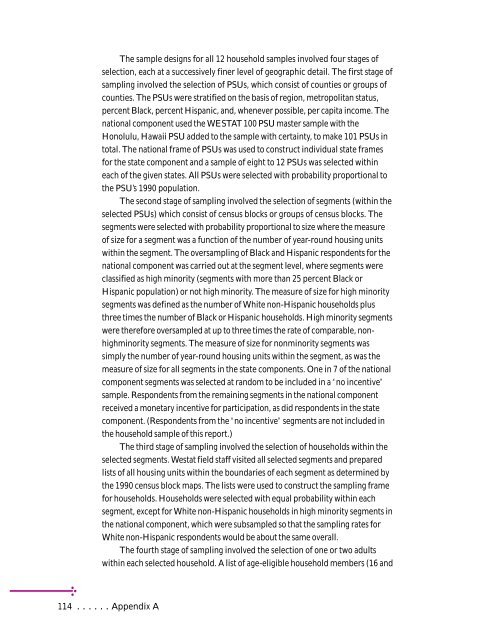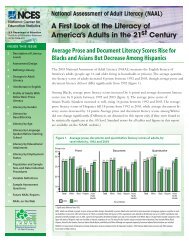Adult Literacy in America - National Center for Education Statistics ...
Adult Literacy in America - National Center for Education Statistics ...
Adult Literacy in America - National Center for Education Statistics ...
Create successful ePaper yourself
Turn your PDF publications into a flip-book with our unique Google optimized e-Paper software.
The sample designs <strong>for</strong> all 12 household samples <strong>in</strong>volved four stages of<br />
selection, each at a successively f<strong>in</strong>er level of geographic detail. The first stage of<br />
sampl<strong>in</strong>g <strong>in</strong>volved the selection of PSUs, which consist of counties or groups of<br />
counties. The PSUs were stratified on the basis of region, metropolitan status,<br />
percent Black, percent Hispanic, and, whenever possible, per capita <strong>in</strong>come. The<br />
national component used the WESTAT 100 PSU master sample with the<br />
Honolulu, Hawaii PSU added to the sample with certa<strong>in</strong>ty, to make 101 PSUs <strong>in</strong><br />
total. The national frame of PSUs was used to construct <strong>in</strong>dividual state frames<br />
<strong>for</strong> the state component and a sample of eight to 12 PSUs was selected with<strong>in</strong><br />
each of the given states. All PSUs were selected with probability proportional to<br />
the PSU’s 1990 population.<br />
The second stage of sampl<strong>in</strong>g <strong>in</strong>volved the selection of segments (with<strong>in</strong> the<br />
selected PSUs) which consist of census blocks or groups of census blocks. The<br />
segments were selected with probability proportional to size where the measure<br />
of size <strong>for</strong> a segment was a function of the number of year-round hous<strong>in</strong>g units<br />
with<strong>in</strong> the segment. The oversampl<strong>in</strong>g of Black and Hispanic respondents <strong>for</strong> the<br />
national component was carried out at the segment level, where segments were<br />
classified as high m<strong>in</strong>ority (segments with more than 25 percent Black or<br />
Hispanic population) or not high m<strong>in</strong>ority. The measure of size <strong>for</strong> high m<strong>in</strong>ority<br />
segments was def<strong>in</strong>ed as the number of White non-Hispanic households plus<br />
three times the number of Black or Hispanic households. High m<strong>in</strong>ority segments<br />
were there<strong>for</strong>e oversampled at up to three times the rate of comparable, nonhighm<strong>in</strong>ority<br />
segments. The measure of size <strong>for</strong> nonm<strong>in</strong>ority segments was<br />
simply the number of year-round hous<strong>in</strong>g units with<strong>in</strong> the segment, as was the<br />
measure of size <strong>for</strong> all segments <strong>in</strong> the state components. One <strong>in</strong> 7 of the national<br />
component segments was selected at random to be <strong>in</strong>cluded <strong>in</strong> a “ no <strong>in</strong>centive”<br />
sample. Respondents from the rema<strong>in</strong><strong>in</strong>g segments <strong>in</strong> the national component<br />
received a monetary <strong>in</strong>centive <strong>for</strong> participation, as did respondents <strong>in</strong> the state<br />
component. (Respondents from the “ no <strong>in</strong>centive” segments are not <strong>in</strong>cluded <strong>in</strong><br />
the household sample of this report.)<br />
The third stage of sampl<strong>in</strong>g <strong>in</strong>volved the selection of households with<strong>in</strong> the<br />
selected segments. Westat field staff visited all selected segments and prepared<br />
lists of all hous<strong>in</strong>g units with<strong>in</strong> the boundaries of each segment as determ<strong>in</strong>ed by<br />
the 1990 census block maps. The lists were used to construct the sampl<strong>in</strong>g frame<br />
<strong>for</strong> households. Households were selected with equal probability with<strong>in</strong> each<br />
segment, except <strong>for</strong> White non-Hispanic households <strong>in</strong> high m<strong>in</strong>ority segments <strong>in</strong><br />
the national component, which were subsampled so that the sampl<strong>in</strong>g rates <strong>for</strong><br />
White non-Hispanic respondents would be about the same overall.<br />
The fourth stage of sampl<strong>in</strong>g <strong>in</strong>volved the selection of one or two adults<br />
with<strong>in</strong> each selected household. A list of age-eligible household members (16 and<br />
114 ......Appendix A



